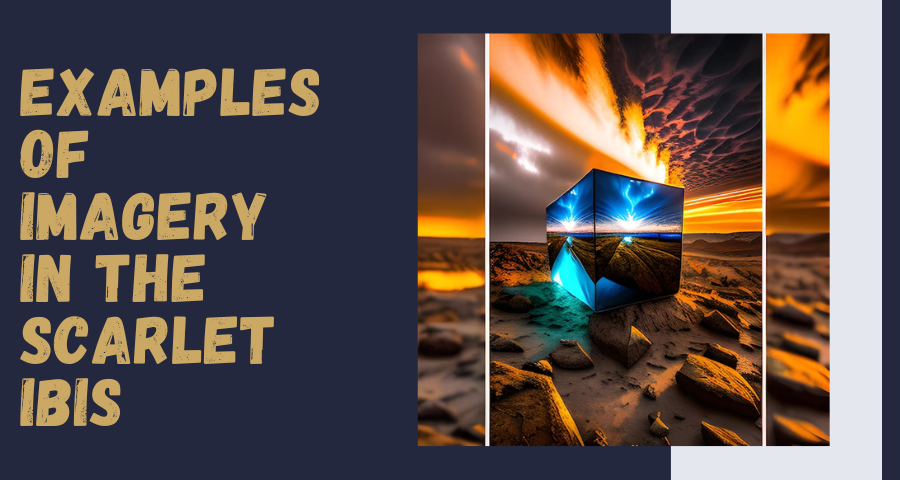James Hurst’s short story “The Scarlet Ibis” is a masterpiece that effectively uses imagery to convey a myriad of emotions and settings. This poignant literary work creates vivid and powerful imagery that brings the story to life. In this article, we will explore 12 examples of imagery in The Scarlet Ibis, analyzing the symbolism, themes, and emotions that they evoke.
Red Imagery in “The Scarlet Ibis”
1. “Red is for Pride”
The story’s title itself, “The Scarlet Ibis,” introduces us to the color red. This crimson hue symbolizes the pride and stubbornness of the older brother towards Doodle, his physically challenged sibling. It’s a harbinger of the tragic events to come.
“The color ‘scarlet’ foreshadows the impending tragedy, hinting at the cost of the brother’s pride.”
2. Blood-Red Summer
The scorching Southern summer is described as “red,” reflecting the oppressive heat that torments the characters. It’s an imagery of discomfort and suffering.
“The ‘red’ summer sets the stage for the brothers’ challenging journey, mirroring their emotional and physical struggles.”
3. The Red Bird
The presence of a “scarlet ibis” in the story introduces a striking image of a rare and beautiful bird against the backdrop of the ordinary, rural landscape.
“The scarlet ibis symbolizes fragility and the tragic beauty of life, offering a stark contrast to the world around it.”
Imagery of Death in “The Scarlet Ibis”
4. The Coffin
Early in the story, the protagonist visualizes a coffin and anticipates Doodle’s death. This ominous image foreshadows the tragic climax.
“The image of the coffin is a haunting reminder of the fragile nature of life, setting a somber tone.”

5. Doodle’s Blood
The sight of Doodle’s blood on the protagonist’s hands after a traumatic incident serves as a vivid symbol of guilt and the irreversible consequences of their actions.
“Doodle’s blood on the brother’s hands is a chilling image of responsibility and regret, haunting the protagonist.”
6. The Dead Scarlet Ibis
The lifeless scarlet ibis found in the family’s garden is a stark representation of death. Its vibrant plumage against the backdrop of decayed leaves emphasizes the beauty and fragility of life.
“The dead scarlet ibis encapsulates the theme of mortality, underscoring the tragedy that unfolds.”
Developing the Mood with Imagery
7. Melancholic Rain
The story’s frequent mentions of rain create a melancholic mood, symbolizing sorrow and foreshadowing the impending tragedy.
“Rain becomes a recurring image, mirroring the characters’ emotions and the story’s somber tone.”
8. Sweltering Heat
The oppressive heat of summer in the South intensifies the discomfort and tension in the narrative.
“The scorching heat amplifies the characters’ physical and emotional struggles, contributing to the story’s atmosphere.”
9. The Bleeding Tree
The “bleeding tree” in the story is a powerful image that reflects the harsh reality of the world, where even nature seems to bleed.
“The bleeding tree symbolizes the harshness of life, highlighting the story’s themes of suffering and sacrifice.”
How Imagery Establishes the Mood
10. Creating Emotional Impact
The rich imagery employed by Hurst serves to immerse the reader in the emotional world of the characters, making their experiences more relatable and impactful.
“Through vivid imagery, readers are drawn into the characters’ emotions, forging a deeper connection with the story.”

11. Foreshadowing and Suspense
Imagery, such as the red color and the coffin, creates an aura of foreshadowing and suspense, keeping readers engaged as they anticipate the story’s climax.
“The imagery of foreshadowing keeps readers on the edge of their seats, eager to uncover the story’s secrets.”
12. Symbolism and Depth
Imagery also adds layers of symbolism and depth to the narrative, allowing for multiple interpretations and a richer reading experience.
“Symbols like the scarlet ibis and bleeding tree enrich the story’s meaning, inviting readers to explore its themes more deeply.”
In “The Scarlet Ibis,” James Hurst masterfully employs imagery to paint a vivid picture of a world filled with emotions, symbolism, and hidden meanings. These examples of imagery bring depth and complexity to the narrative, making it a timeless work of literature.
FAQs
Why is the scarlet ibis significant in the story?
The scarlet ibis is significant because it symbolizes the fragility and tragic beauty of life. Its appearance in the story foreshadows the tragedy that unfolds and adds depth to the narrative.
How does the imagery of red contribute to the story’s mood?
The color red, often associated with pride and suffering, sets a somber and foreboding mood in the story, hinting at the impending tragedy.
What role does rain play in “The Scarlet Ibis”?
Rain is a recurring image in the story, creating a melancholic mood and symbolizing sorrow and foreshadowing. It adds emotional depth to the narrative.
How does the bleeding tree contribute to the story’s themes?
The bleeding tree symbolizes the harshness of life and the world’s cruelty. It reinforces the themes of suffering and sacrifice present in the story.

